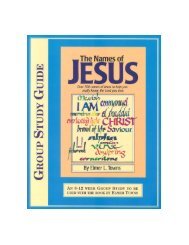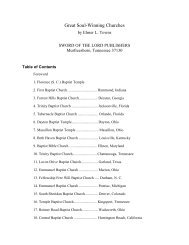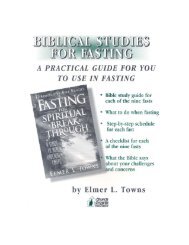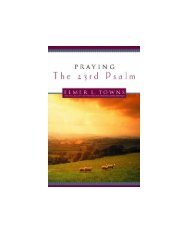PUTTING AN END TO WORSHIP WARS - Elmer Towns
PUTTING AN END TO WORSHIP WARS - Elmer Towns
PUTTING AN END TO WORSHIP WARS - Elmer Towns
- TAGS
- worship
- elmer
- towns
- elmertowns.com
Create successful ePaper yourself
Turn your PDF publications into a flip-book with our unique Google optimized e-Paper software.
The pastors told me they had not changed their doctrine, they were Baptists, supported the<br />
cooperative program and didn't believe in the miraculous gift. But their worship style was the<br />
issue.<br />
Renewal churches can be found among Presbyterians, Episcopal, Roman Catholic,<br />
Pentecostal and the rapidly emerging independent churches. Theology is not the dividing line,<br />
hence doctrine is not the glue that holds them together. They may preach "power theology,"<br />
"prosperity theology," pentecostalism or in some cases old-fashioned liberalism. Whatever their<br />
thrust, most of them are evangelical in doctrine.<br />
The emphasis in these churches is on personal renewal in fellowship with God. This style<br />
of worship is not found in the formal services of a liturgical church, but in the intense experience<br />
of pouring out personal love for God.<br />
Whereas formal liturgy emphasizes one way worship toward God, i.e. giving worship to<br />
God that is due him, worship in a Renewal Church focuses on two-way communication between<br />
the person and God. Worshipers must get something out of worship. It must be stimulating,<br />
uplifting, and exhilarating. They like worship, and it affirms them. When they go home, they<br />
feel good about what they have done.<br />
THE BODY LIFE CHURCH<br />
The glue that holds this church together is the relationships that are formed in the small<br />
groups or cells that make up the Body. It is in the small groups that pastoral care happens and<br />
people grow spiritually. A Body-life church has a lot of hugging going on and places value on<br />
transparency-being open and honest and caring in their groups. They confess faults to one<br />
another, are accountable to one another and pray for one another.<br />
Body-life churches do the other things that normal churches do, such as preach, sing,<br />
teach and worship God. But they prize highly the quality of life they receive form relationships.<br />
In a given session they might testify, share burdens, pray for a hurting brother and share a<br />
blessing or an answer to prayer. It is "the Body ministering to the Body."<br />
A Body-life church is not a pulpit-dominated church where everyone looks to the pastor<br />
for ministry. Instead, a Body-life church congregation looks to one another for support, help and<br />
ministry. It focuses on koinonia or fellowship within the Body.<br />
Just as in the other cases, Body-life churches are found in Baptist, Evangelical Free,<br />
Independent or Pentecostal churches. The influence of koinonia crosses denominational lines. It<br />
is not a church style that is taught in most seminaries, however. Pastors learn it from one<br />
another, from conferences, from seminars or as they intern under a Body-Life Church pastor.<br />
THE LITURGICAL CHURCH<br />
The traditional formality of this worship style was described earlier in this chapter. In<br />
some churches, the style of worship has not changed since the denomination's founding, and<br />
people sing the same hymns that were sung by their grandparents. They feel that worship is
















